All Lessons
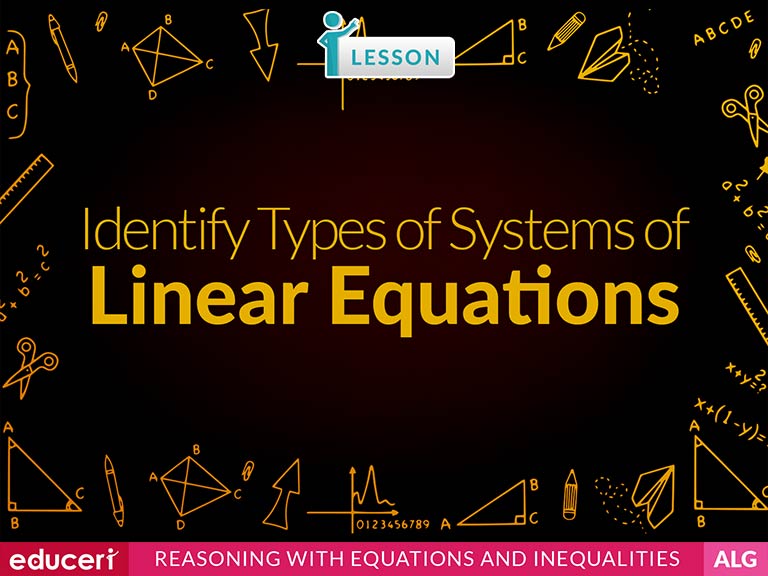
Identify Types of Systems of Linear Equations
8.EE.8.B Solve systems of two linear equations in two variables algebraically, and estimate solutions by graphing the equations. Solve simple cases by inspection. For example, 3x + 2y = 5 and 3x + 2y = 6 have no solution because 3x + 2y cannot simultaneously be 5 and 6.
HSA.REI.6HSA.REI.6 Solve systems of linear equations exactly and approximately (e.g., with graphs), focusing on pairs of linear equations in two variables.
HSA.REI.10HSA.REI.10 Understand that the graph of an equation in two variables is the set of all its solutions plotted in the coordinate plane, often forming a curve (which could be a line).
Share This Lesson
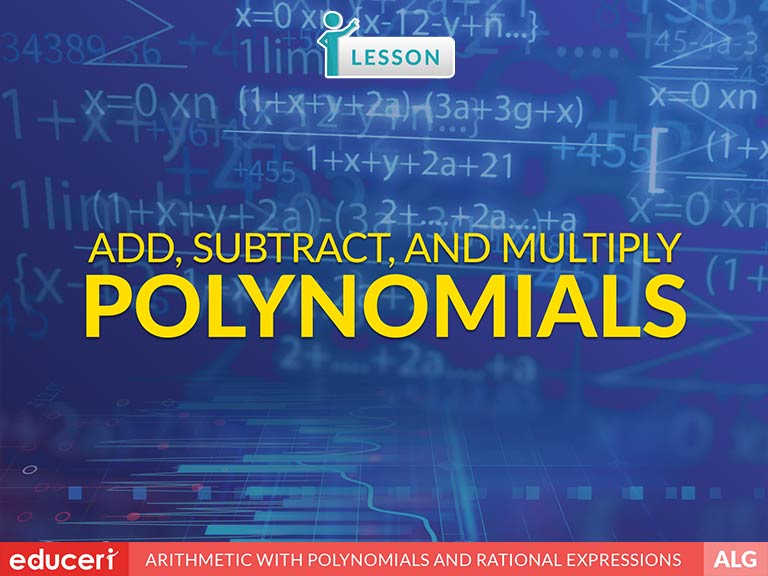
Add, Subtract, and Multiply Polynomials
Share This Lesson

Simplify Expressions with Roots
8.EE.2 Use square root and cube root symbols to represent solutions to equations of the form x2 = p and x3 = p, where p is a positive rational number. Evaluate square roots of small perfect squares and cube roots of small perfect cubes. Know that √2 is irrational.
HSN.RN.1HSN.RN.1 Explain how the definition of the meaning of rational exponents follows from extending the properties of integer exponents to those values, allowing for a notation for radicals in terms of rational exponents. For example, we define 5^(1/3) to be the cube root of 5 because we want (5^(1/3))^3 = (5^(1/3))^3 to hold, so (5^(1/3))^3 must equal 5.
HSN.RN.2HSN.RN.2 Rewrite expressions involving radicals and rational exponents using the properties of exponents.
Share This Lesson

Factor Quadratic Expressions - Part 1
(8) Quadratic functions and equations. The student applies the mathematical process standards to solve, with and without technology, quadratic equations and evaluate the reasonableness of their solutions. The student formulates statistical relationships and evaluates their reasonableness based on real-world data.
A1.8.A(A) Solve quadratic equations having real solutions by factoring, taking square roots, completing the square, and applying the quadratic formula
Share This Lesson

Factor Quadratic Expressions - Part 2
(8) Quadratic functions and equations. The student applies the mathematical process standards to solve, with and without technology, quadratic equations and evaluate the reasonableness of their solutions. The student formulates statistical relationships and evaluates their reasonableness based on real-world data.
A1.8.A(A) Solve quadratic equations having real solutions by factoring, taking square roots, completing the square, and applying the quadratic formula
Share This Lesson

Solve Exponential Equations
(C) Write exponential functions in the form f(x) = abx (where b is a rational number) to describe problems arising from mathematical and real-world situations, including growth and decay
A2.5.D(D) Solve exponential equations of the form y = abx where a is a nonzero real number and b is greater than zero and not equal to one and single logarithmic equations having real solutions
PCAL.5.I(I) Generate and solve exponential equations in mathematical and real-world problems
Share This Lesson
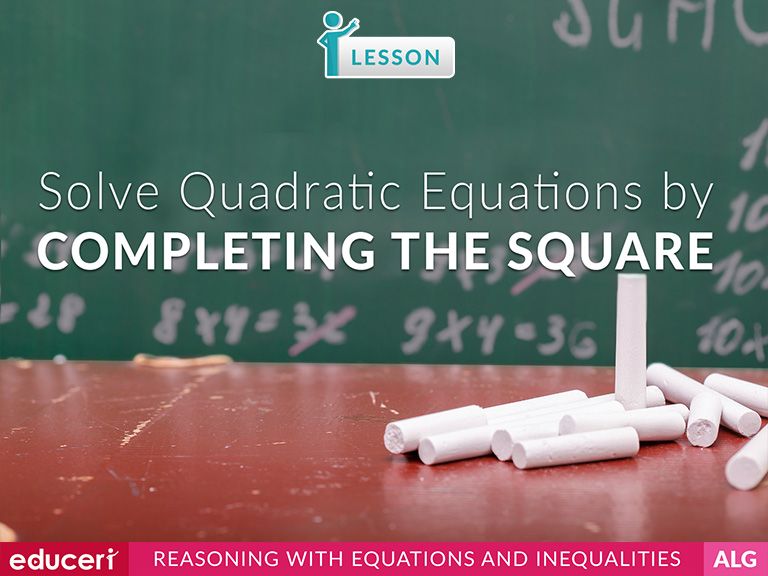
Solve Quadratic Equations by Completing the Square
HSA.REI.4.A Use the method of completing the square to transform any quadratic equation in x into an equation of the form (x - p)2 = q that has the same solutions. Derive the quadratic formula from this form.
HSA.REI.4.BHSA.REI.4.B Solve quadratic equations by inspection (e.g., for x^2 = 49), taking square roots, completing the square, the quadratic formula and factoring, as appropriate to the initial form of the equation. Recognize when the quadratic formula gives complex solutions and write them as a ± bi for real numbers a and b.
Share This Lesson

Graph Linear Functions by Plotting Ordered Pairs
(C) Contrast bivariate sets of data that suggest a linear relationship with bivariate sets of data that do not suggest a linear relationship from a graphical representation
A1.3.C(C) Graph linear functions on the coordinate plane and identify key features, including x-intercept, y-intercept, zeros, and slope, in mathematical and real-world problems
8.EE.6 Use similar triangles to explain why the slope m is the same between any two distinct points on a non-vertical line in the coordinate plane; derive the equation y = mx for a line through the origin and the equation y = mx + b for a line intercepting the vertical axis at b.
HSA.REI.10HSA.REI.10 Understand that the graph of an equation in two variables is the set of all its solutions plotted in the coordinate plane, often forming a curve (which could be a line).
HSF.IF.7.AHSF.IF.7.A Graph linear and quadratic functions and show intercepts, maxima, and minima.
This expressions and equations lesson teaches students how to graph linear functions by plotting ordered pairs. The lesson includes research-based strategies and strategic questions that prepare students for assessments. In this lesson, students will plot ordered pairs from a linear function on the coordinate plane.
Share This Lesson
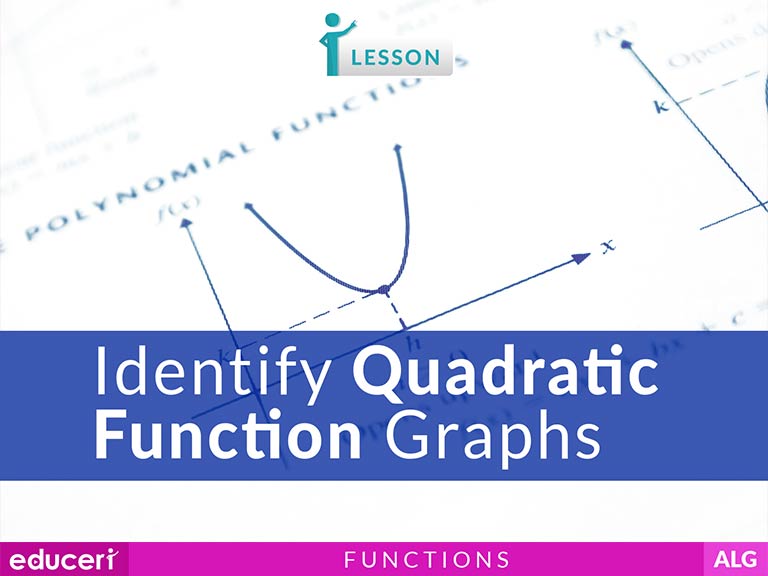
Identify Quadratic Function Graphs
(7) Quadratic functions and equations. The student applies the mathematical process standards when using graphs of quadratic functions and their related transformations to represent in multiple ways and determine, with and without technology, the solutions to equations.
A1.7.A(A) Graph quadratic functions on the coordinate plane and use the graph to identify key attributes, if possible, including x-intercept, y-intercept, zeros, maximum value, minimum values, vertex, and the equation of the axis of symmetry
A1.7.B(B) Describe the relationship between the linear factors of quadratic expressions and the zeros of their associated quadratic functions
A1.7.C(C) Determine the effects on the graph of the parent function f(x) = x2 when f(x) is replaced by af(x), f(x) + d, f(x - c), f(bx) for specific values of a, b, c, and d.
Share This Lesson

Identify and Graph Transformed Functions
(E) Determine the effects on the graph of the parent function f(x) = x when f(x) is replaced by af(x), f(x) + d, f(x - c), f(bx) for specific values of a, b, c, and d
A1.7.C(C) Determine the effects on the graph of the parent function f(x) = x2 when f(x) is replaced by af(x), f(x) + d, f(x - c), f(bx) for specific values of a, b, c, and d.
Share This Lesson

Find Zeros of Quadratic Functions by Factoring
(7) Quadratic functions and equations. The student applies the mathematical process standards when using graphs of quadratic functions and their related transformations to represent in multiple ways and determine, with and without technology, the solutions to equations.
A1.7.B(B) Describe the relationship between the linear factors of quadratic expressions and the zeros of their associated quadratic functions
HSF.IF.8 Write a function defined by an expression in different but equivalent forms to reveal and explain different properties of the function.
HSF.IF.8.AHSF.IF.8.A Use the process of factoring and completing the square in a quadratic function to show zeros, extreme values, and symmetry of the graph, and interpret these in terms of a context.
Share This Lesson

Identify Key Points from Quadratic Function Graphs
(7) Quadratic functions and equations. The student applies the mathematical process standards when using graphs of quadratic functions and their related transformations to represent in multiple ways and determine, with and without technology, the solutions to equations.
A1.7.A(A) Graph quadratic functions on the coordinate plane and use the graph to identify key attributes, if possible, including x-intercept, y-intercept, zeros, maximum value, minimum values, vertex, and the equation of the axis of symmetry
A1.7.B(B) Describe the relationship between the linear factors of quadratic expressions and the zeros of their associated quadratic functions
A1.7.C(C) Determine the effects on the graph of the parent function f(x) = x2 when f(x) is replaced by af(x), f(x) + d, f(x - c), f(bx) for specific values of a, b, c, and d.
A1.8(8) Quadratic functions and equations. The student applies the mathematical process standards to solve, with and without technology, quadratic equations and evaluate the reasonableness of their solutions. The student formulates statistical relationships and evaluates their reasonableness based on real-world data.
A1.8.A(A) Solve quadratic equations having real solutions by factoring, taking square roots, completing the square, and applying the quadratic formula
HSF.IF.8 Write a function defined by an expression in different but equivalent forms to reveal and explain different properties of the function.
HSF.IF.8.AHSF.IF.8.A Use the process of factoring and completing the square in a quadratic function to show zeros, extreme values, and symmetry of the graph, and interpret these in terms of a context.
HSF.IF.8.BHSF.IF.8.B Use the properties of exponents to interpret expressions for exponential functions. For example, identify percent rate of change in functions such as y = (1.02)ᵗ, y = (0.97)ᵗ, y = (1.01)12ᵗ, y = (1.2)ᵗ/10, and classify them as representing exponential growth or decay.
Share This Lesson
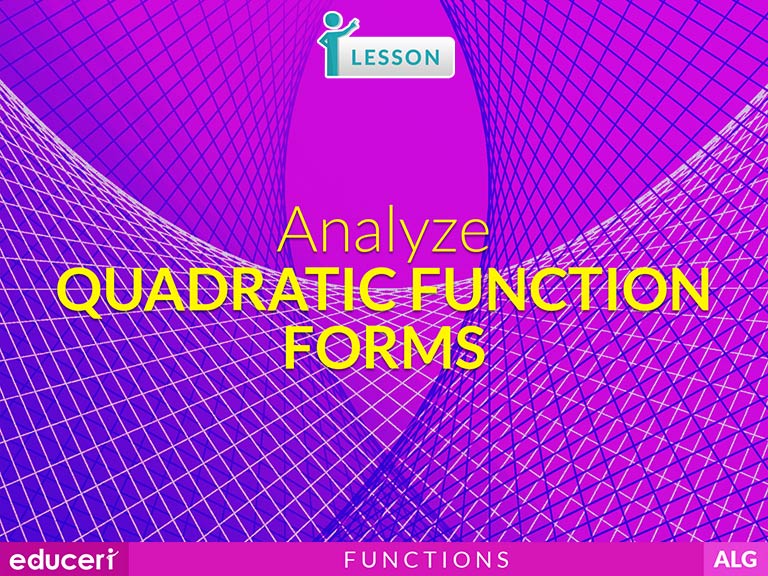
Analyze Quadratic Function Forms
(B) Write equations of quadratic functions given the vertex and another point on the graph, write the equation in vertex form (f(x) = a(x - h)2+ k), and rewrite the equation from vertex form to standard form (f(x) = ax2+ bx + c)
A1.7.B(B) Describe the relationship between the linear factors of quadratic expressions and the zeros of their associated quadratic functions






